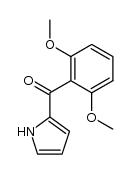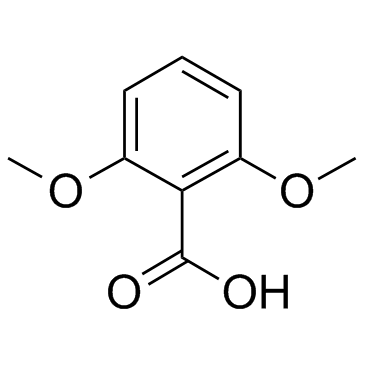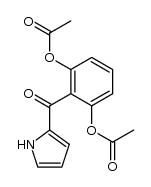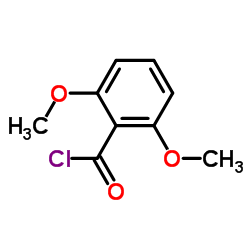25683-07-2
| Name | (4,5-dichloro-1H-pyrrol-2-yl)-(2,6-dihydroxyphenyl)methanone |
|---|---|
| Synonyms |
Pyoluteorin
KETONE,4,5-DICHLOROPYRROL-2-YL 2,6-DIHYDROXYPHENYL Methanone,(4,5-dichloro-1H-pyrrol-2-yl)(2,6-dihydroxyphenyl) (4,5-Dichlor-pyrrol-2-yl)-(2,6-dihydroxy-phenyl)-keton (4,5-dichloro-pyrrol-2-yl)-(2,6-dihydroxy-phenyl)-methanone (4,5-dichloro-pyrrol-2-yl)-(2,6-dihydroxy-phenyl)-ketone WLN: T5MJ BG CG EVR BQ FQ |
| Description | Pyoluteorin is an antibiotic that inhibits Oomycete fungi, including the plant pathogen Pythium ultimum, and suppresses plant diseases caused by this fungus[1]. Pyoluteorin induces human triple-negative breast cancer MDA-MB-231 cells apoptosis in vitro. Pyoluteorin can be used for the research of human triple-negative breast cancer[2]. |
|---|---|
| Related Catalog | |
| In Vitro | Pyoluteorin is an antifungal compound composed of a bichlorinated pyrrole linked to a resorcinol moiety, were identified within a 24-kb genomic region of Pseudomonas fluorescens Pf-5[1]. Pyoluteorin has significant cytotoxicity towards MCF-7 (IC50=1.84 μM). Pyoluteorin also displays significantly selective cytotoxicity against BT474, HCC1954, MAD-MB-468, MDA-MB-231, and MCF-10A cells with IC50s of 9.75±0.16, 0.94±0.01, 3.89±0.08, 0.97±0.01, and 57.01±0.76 μM, respectively[2]. Pyoluteorin (0.1-10 μM; for 24 hours) induces change of apoptosis-related protein expressions. Pyoluteorin-induced cell apoptosis in MDA-MB-231 is related to Bcl-2 family proteins and caspase cascade[2]. Pyoluteorin (0.1-10 μM; for 24 h) induces cell cycle arrest and apoptosis in human triple-negative breast cancer cells MDA-MB-231[2]. Cell Proliferation Assay[2] Cell Line: Human triple-negative breast cancer cell MDA-MB-231 Concentration: 0, 0.032, 0.16, 0.8, 4, 20, 100 μM Incubation Time: 24, 48, 72 hours Result: Inhibited cells proliferation in a dose- and time-dependent manner. Western Blot Analysis[2] Cell Line: MDA-MB-231 cells Concentration: 0.1, 0.3, 1, 3, 10 μM Incubation Time: 24 hours Result: The levels of the anti-apoptotic proteins Bcl-2, Bcl-XL and PARP were obviously decreased while the pro-apoptotic proteins BAX and caspase 3 were increased in a dose-dependent manner. |
| References |
| Density | 1.632g/cm3 |
|---|---|
| Boiling Point | 436.9ºC at 760mmHg |
| Molecular Formula | C11H7Cl2NO3 |
| Molecular Weight | 272.08400 |
| Flash Point | 218ºC |
| Exact Mass | 270.98000 |
| PSA | 73.32000 |
| LogP | 2.96370 |
| Vapour Pressure | 3.06E-08mmHg at 25°C |
| Index of Refraction | 1.694 |
CHEMICAL IDENTIFICATION
HEALTH HAZARD DATAACUTE TOXICITY DATA
|
| HS Code | 2933990090 |
|---|
|
~92% 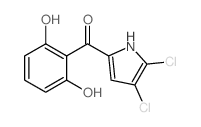
25683-07-2 |
| Literature: Cue Jr.; Dirlam; Czuba; Windisch Journal of Heterocyclic Chemistry, 1981 , vol. 18, # 1 p. 191 - 192 |
|
~% 
25683-07-2 |
| Literature: Cue Jr.; Dirlam; Czuba; Windisch Journal of Heterocyclic Chemistry, 1981 , vol. 18, # 1 p. 191 - 192 |
|
~% 
25683-07-2 |
| Literature: Cue Jr.; Dirlam; Czuba; Windisch Journal of Heterocyclic Chemistry, 1981 , vol. 18, # 1 p. 191 - 192 |
|
~% 
25683-07-2 |
| Literature: Cue Jr.; Dirlam; Czuba; Windisch Journal of Heterocyclic Chemistry, 1981 , vol. 18, # 1 p. 191 - 192 |
|
~% 
25683-07-2 |
| Literature: Cue Jr.; Dirlam; Czuba; Windisch Journal of Heterocyclic Chemistry, 1981 , vol. 18, # 1 p. 191 - 192 |
|
~% 
25683-07-2 |
| Literature: Cue Jr.; Dirlam; Czuba; Windisch Journal of Heterocyclic Chemistry, 1981 , vol. 18, # 1 p. 191 - 192 |
| Precursor 6 | |
|---|---|
| DownStream 0 | |
| HS Code | 2933990090 |
|---|---|
| Summary | 2933990090. heterocyclic compounds with nitrogen hetero-atom(s) only. VAT:17.0%. Tax rebate rate:13.0%. . MFN tariff:6.5%. General tariff:20.0% |


